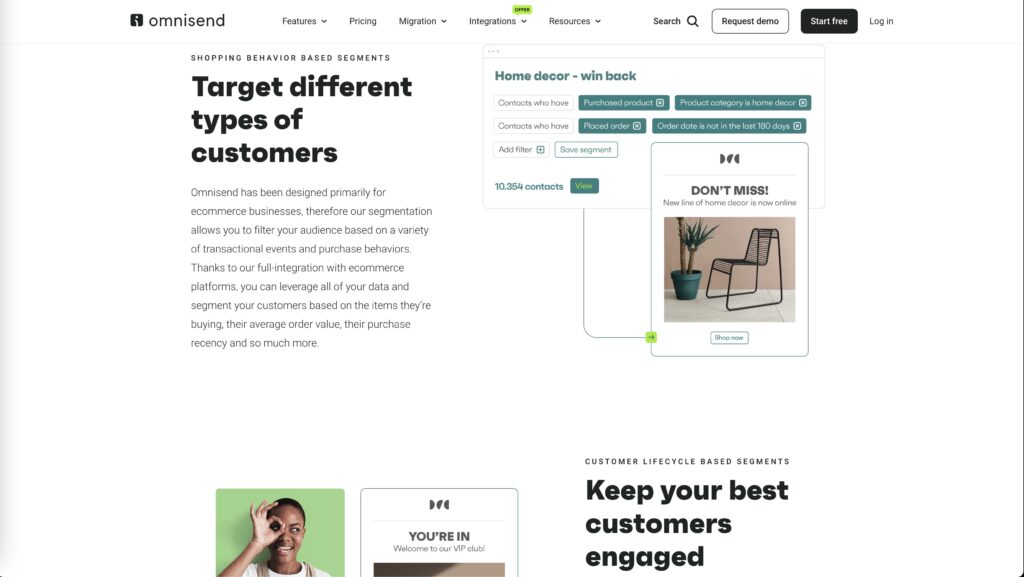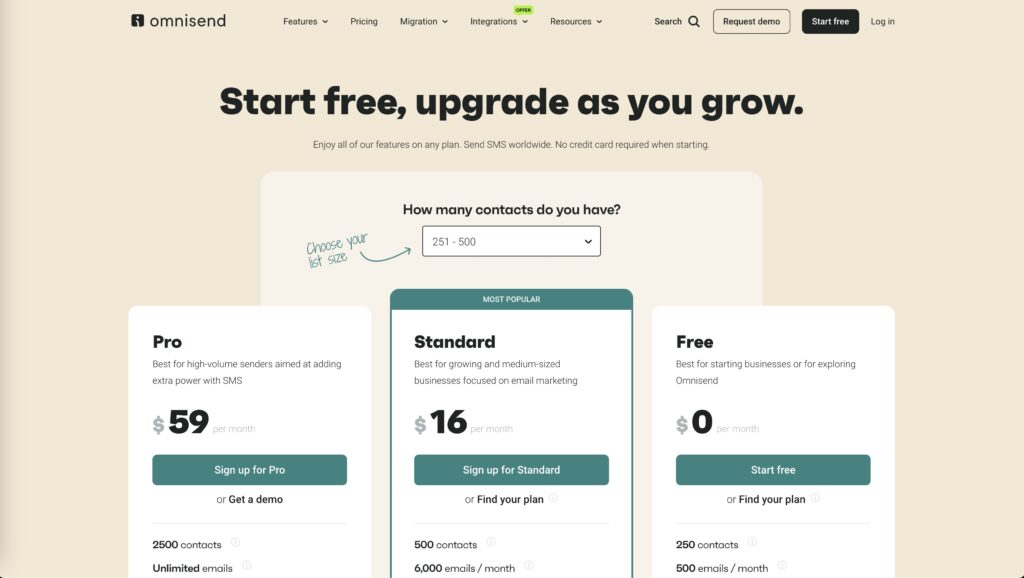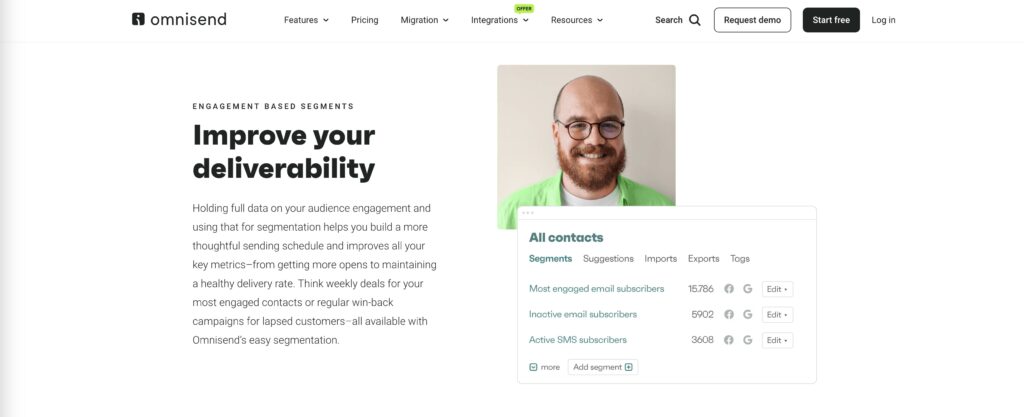Comparing Omnisend vs Mailchimp? Learn which tool offers better integrations, advanced eCommerce features, and higher deliverability for your business.
TL;DR:
Selecting the best email marketing platform is vital for your business’s success. Omnisend and Mailchimp are both popular options, each offering unique advantages. Omnisend is ideal for eCommerce businesses with its specialized features, while Mailchimp offers simplicity and versatility for a broader audience. This post breaks down their key strengths to help you choose the right fit for your business.
Table of Contents

Introduction to Omnisend vs Mailchimp
When it comes to email marketing, two platforms often come into the discussion: Omnisend vs Mailchimp. These platforms have powered thousands of businesses with their marketing strategies, offering features that help brands connect with their audiences, drive engagement, and increase conversions. However, as similar as they may seem, they cater to different types of businesses, each excelling in specific areas. The question then arises: how do you choose between them?
In 2024, both Omnisend and Mailchimp have rolled out significant updates that aim to improve their functionality and user experience, making the choice more nuanced than ever. For eCommerce businesses, Omnisend has rapidly gained an edge due to its deep integration with eCommerce platforms like Shopify and WooCommerce, as well as its advanced tools for segmentation, automation, and multi-channel marketing. For businesses looking to streamline customer journeys and sales through targeted marketing, Omnisend’s focus on eCommerce is hard to beat.
On the other hand, Mailchimp remains a solid, versatile choice, especially for general businesses or startups that prioritize simplicity and ease of use. Mailchimp’s wide array of features, including basic email marketing, audience segmentation, and even social media ads, make it a go-to platform for businesses that need a straightforward yet effective tool. It’s a great fit for companies that require flexibility and don’t necessarily rely on heavy eCommerce features.
At their core, both platforms allow you to create and schedule email campaigns, automate marketing workflows, and track the performance of your efforts. But the key differences lie in their approach to pricing, ease of use, customization options, and advanced features. For example, while Mailchimp offers a free plan, it comes with certain limitations that might restrict businesses as they scale, especially when it comes to automation and advanced reporting. Omnisend, while it doesn’t offer a fully free plan, provides eCommerce businesses with a suite of tools specifically designed to maximize revenue and customer engagement.
Choosing the right email marketing platform depends on several factors, including the size of your business, your industry, and how deeply you want to integrate email with other marketing channels like SMS and push notifications. Businesses heavily involved in online retail might lean toward Omnisend’s eCommerce-centered tools, while businesses looking for a more flexible and generalist platform might find Mailchimp better suited to their needs.
Whether you’re a small startup just beginning to build your customer base or a growing eCommerce store seeking powerful automation and segmentation tools, the decision between Omnisend vs Mailchimp should be driven by your business’s specific goals and requirements. With this comparison, you’ll gain insights into how each platform can benefit your email marketing efforts and which one is more likely to help you grow your brand in 2024.
Feature Comparison: Omnisend vs Mailchimp

Ease of Use: Omnisend vs Mailchimp
One of the first things you’ll notice when trying out these platforms is the difference in ease of use. Mailchimp is known for its intuitive interface that caters to both beginners and experienced marketers. You don’t need to be a tech wizard to create a campaign here, which makes it an attractive option for small businesses.
On the other hand, Omnisend has an eCommerce-focused dashboard that might seem a bit overwhelming at first. However, for businesses heavily involved in eCommerce, this extra complexity can be worth it. Omnisend’s tailored features become highly valuable as you get used to its flow.
Mailchimp’s simplicity can be a huge benefit if you’re looking for an easy way to manage email marketing without spending too much time learning the platform. However, if you’re running an online store and want more depth, Omnisend’s dashboard, once mastered, provides more powerful features, especially with its segmentation and automation.
Email Design & Templates: Omnisend vs Mailchimp
When it comes to email design, both Omnisend vs Mailchimp provide a range of pre-designed templates to simplify the creation process. These templates allow businesses to create professional-looking emails without needing extensive design skills. However, the design quality and customization options between the two platforms vary significantly, which can influence the overall effectiveness of your email marketing campaigns.
Mailchimp offers a wide selection of email templates, catering to a broad range of industries and business types. While the platform’s templates are certainly functional, many users have noted that they can feel somewhat generic. For businesses looking for a quick, straightforward solution, Mailchimp’s templates get the job done. However, for those who want their emails to stand out in a crowded inbox, Mailchimp’s designs might fall short in delivering the “wow” factor. Additionally, while Mailchimp allows customization, the degree to which you can modify templates is somewhat limited, especially if you want to create complex, visually stunning emails.

Omnisend, on the other hand, elevates email design with its visually striking, modern templates that are specifically tailored for eCommerce. Omnisend’s templates are designed to be more eye-catching and engaging, with greater emphasis on aesthetics and user experience. One of the key strengths of Omnisend is that it enables a higher level of customization, allowing businesses to design emails that not only look professional but also feel highly personalized to their brand identity. Whether you’re a fashion retailer, tech brand, or a boutique store, Omnisend gives you the tools to craft emails that look and feel unique, ensuring your marketing efforts resonate more deeply with your target audience.
Another significant advantage of Omnisend is its built-in support for eCommerce-specific features. For instance, Omnisend allows businesses to embed product recommendations directly into their emails, which can help drive repeat purchases and increase average order values. You can also insert dynamic discount codes and personalized offers right into the email template, making it easy to incentivize action from your subscribers. These features are incredibly valuable for eCommerce businesses, as they are specifically designed to boost conversions by delivering relevant, timely offers to customers. Mailchimp, while versatile for general business use, doesn’t offer the same depth of eCommerce integration within its templates, making it more suited for broad email campaigns rather than ones focused on driving online sales.

For businesses that rely heavily on visual branding, Omnisend’s customizable templates and dynamic content blocks provide the flexibility to create visually engaging, on-brand emails. You can match your email designs to your website’s look and feel, ensuring that your branding remains consistent across all channels. This level of customization helps create a cohesive customer experience, which is vital for businesses that want to build trust and brand recognition.
While Mailchimp’s editor is also a drag-and-drop format, it lacks some of the advanced customization options that Omnisend provides, particularly for eCommerce-specific needs. The editor is functional but doesn’t offer the dynamic content capabilities that allow emails to adjust based on user behavior. Additionally, Mailchimp’s templates are not as tailored to eCommerce as Omnisend’s, which could limit your ability to create highly targeted and conversion-focused email campaigns if you’re running an online store.
In summary, if your primary goal is to create unique, visually stunning emails that catch the eye and encourage action, Omnisend clearly takes the lead. Its combination of modern templates, dynamic content blocks, and built-in eCommerce tools make it a powerful option for businesses looking to maximize their email marketing efforts. Mailchimp remains a solid choice for more general email campaigns, but for eCommerce businesses or those needing a higher degree of customization and personalization, Omnisend offers the features needed to truly stand out.
Segmentation & Personalization: Omnisend vs Mailchimp
Segmentation is crucial in email marketing, and both Omnisend vs Mailchimp offer robust segmentation features. However, Omnisend is particularly renowned for its advanced segmentation capabilities, especially when it comes to eCommerce businesses. Segmentation allows businesses to divide their audience into smaller, more defined groups based on a range of criteria, which is essential for personalizing email content and improving overall marketing performance.
In Omnisend, segmentation is taken to the next level. While both platforms enable businesses to segment their audiences based on general data, such as demographics or user activity, Omnisend offers a deeper level of detail specifically tailored to eCommerce. You can segment your audience by critical behaviors like purchase frequency, total spending, cart abandonment, and even browse history. For example, Omnisend allows you to track customers who have viewed certain products without purchasing or those who have left items in their cart multiple times. This detailed breakdown enables you to create hyper-targeted campaigns that are far more likely to convert.

Imagine being able to send highly customized offers to customers who purchased from a specific product category more than twice in the last 30 days, or re-engaging customers who haven’t made a purchase in over six months with a tailored discount code. Omnisend makes this possible through its deep behavioral segmentation, which is a game changer for eCommerce businesses trying to maximize engagement and conversions. The platform’s ability to track granular customer interactions gives businesses a powerful edge in delivering personalized marketing experiences.
Another standout feature is Omnisend’s dynamic segmentation. This means that your audience lists automatically update as customer behaviors change. For instance, if a customer who previously hadn’t made a purchase in a long time suddenly buys again, they are automatically moved out of a “lapsed customers” segment and into a more appropriate active customer group. This dynamic approach ensures that your email campaigns remain relevant and targeted without the need for constant manual updates.

Mailchimp, while highly versatile, offers a more straightforward segmentation process, which works well for general businesses or smaller organizations. With Mailchimp, you can segment by demographics, engagement levels, or geographic location, which is beneficial for targeting broad customer groups. However, for businesses needing more nuanced targeting—especially those in eCommerce—Mailchimp’s options may not be enough. You can, for instance, segment based on open rates or clicks, but tracking specific actions such as product category interest or cart abandonment is limited compared to what Omnisend can achieve.

Mailchimp’s segmentation tools also lack the automation flexibility that Omnisend provides. Omnisend’s automation workflows are directly linked to the segmentation criteria, allowing businesses to set up trigger-based campaigns for each segment. For example, you could automatically trigger a post-purchase email series for customers who have just completed a purchase, or send an abandoned cart reminder to customers who have left items in their cart without checking out. While Mailchimp offers some automation features, Omnisend’s granular control over these workflows ensures more relevant and effective communication with customers at every stage of the buying journey.
Advanced Features & Customization: Omnisend vs Mailchimp
While both Omnisend vs Mailchimp offer a variety of features for email marketing, Omnisend distinguishes itself with advanced options tailored specifically for eCommerce businesses. One standout feature is SMS marketing integration, which allows businesses to reach customers through both email and text messages from one platform. This multi-channel approach can significantly boost engagement by reaching customers where they’re most active.
In addition to SMS, Omnisend includes push notifications and web push alerts, making it a comprehensive marketing automation solution. These tools allow businesses to engage customers in real-time with personalized alerts, such as reminders, promotions, and updates. Omnisend even enables multi-channel automation workflows, combining email, SMS, and push notifications to create a seamless customer experience. For example, you can automate an abandoned cart series that starts with an email, follows with an SMS, and ends with a push notification.

On the other hand, Mailchimp focuses more on general business use. It offers basic landing pages, simple ads, and some social media integration, which work well for standard marketing campaigns. However, it lacks the depth and multi-channel coordination that Omnisend provides, particularly for eCommerce businesses needing integrated automation across multiple channels.
Overall, if you’re running an eCommerce business and need advanced tools like SMS integration and push notifications, Omnisend offers a more comprehensive, all-in-one platform. Mailchimp is great for general use but doesn’t match the multi-channel capabilities and automation depth of Omnisend.
Pricing Battle: Omnisend vs Mailchimp
Pricing is always a hot topic when choosing a marketing platform, and it’s no different when it comes to Omnisend vs Mailchimp. Mailchimp has a free tier, making it an attractive option for startups and small businesses looking to save costs. However, its free tier comes with limitations on automation, customer support, and features.
Omnisend doesn’t offer a completely free tier but does have a generous free plan for those who need only basic email marketing tools. As your business grows, Omnisend’s paid plans provide more value, especially when compared to Mailchimp’s, as they are focused on features tailored for eCommerce businesses.

Mailchimp’s paid plans increase significantly in price as your subscriber list grows, which can quickly become a cost burden for businesses looking to scale. Omnisend’s pricing, while not the cheapest, scales better for companies focused on increasing revenue through highly targeted campaigns.

Analytics & Reporting: Who Does It Better, Omnisend vs Mailchimp?
Both Omnisend and Mailchimp offer detailed analytics that help track key metrics like open rates, click-through rates, and conversions. However, Omnisend stands out by providing more eCommerce-specific insights, such as tracking customer behavior post-email, revenue generated from each campaign, and the effectiveness of automation workflows. This allows eCommerce businesses to tie email performance directly to sales, making it easier to optimize their strategies.

Omnisend also offers deeper reporting on SMS campaigns and integrates this data into its overall marketing reports, giving businesses a multi-channel view of their marketing efforts. Additionally, revenue attribution features allow businesses to track how much income each campaign generates, a feature that’s particularly valuable for online stores.
Mailchimp, while strong in visualizing general engagement metrics like audience growth and click-through rates, lacks the revenue-focused insights that Omnisend provides. It’s a solid tool for tracking basic engagement, but for businesses that need to focus on sales and conversions, Omnisend’s tailored analytics offer more depth and precision.

In summary, for eCommerce businesses looking for detailed, revenue-driven reports, Omnisend is the superior choice. Mailchimp excels in general business metrics but doesn’t match Omnisend’s advanced, sales-focused reporting.
Integrations and eCommerce Focus: Omnisend vs Mailchimp
For businesses centered on eCommerce, Omnisend is the superior option due to its seamless integration with major platforms like Shopify, WooCommerce, and BigCommerce. These integrations allow real-time syncing of customer data, order histories, and product information, enabling businesses to create highly targeted, automated workflows. For example, Omnisend makes it easy to set up abandoned cart reminders and personalize them with real-time product data, boosting conversions significantly.

Mailchimp also integrates with eCommerce platforms, but its tools are more generalized. While it offers abandoned cart emails and product recommendations, it lacks the depth of Omnisend’s eCommerce-focused features. Omnisend’s advanced segmentation based on shopping behavior and multi-channel marketing (email, SMS, and push notifications) ensures businesses can reach customers across multiple channels, driving higher engagement and sales.
For businesses not entirely focused on eCommerce, Mailchimp may suffice with its simpler integrations and broader use case. However, for eCommerce businesses needing deeper automation and segmentation, Omnisend is the clear choice with its more comprehensive eCommerce tools and integrations designed for driving online sales.

Deliverability Rates: How Reliable Are They?
Deliverability rates are crucial for ensuring your emails reach your audience’s inbox. Omnisend is known for its impressive deliverability, largely due to its strong focus on list hygiene and maintaining a clean sender reputation. By helping businesses remove inactive subscribers, Omnisend improves the chances of emails avoiding spam filters. Its multi-channel approach, incorporating SMS and push notifications, further ensures that your message reaches customers, even if email deliverability faces challenges.

Mailchimp also offers solid deliverability but tends to have stricter spam filters, which can cause issues if your email list isn’t perfectly clean. While Mailchimp provides tools to track deliverability and maintain list health, its stricter filtering policies may result in more emails being marked as spam, especially for less refined lists.
Overall, both platforms offer reliable deliverability, but Omnisend‘s multi-channel approach and more lenient filtering make it particularly well-suited for eCommerce businesses that need to ensure high engagement across various channels.
Mobile Optimization & Usability: Omnisend vs Mailchimp
In today’s world, having mobile-optimized email campaigns is a must. Omnisend ensures that all its templates are fully responsive, which means your emails will look great whether they’re viewed on a desktop or a mobile device.
Mailchimp also offers mobile-responsive designs, but Omnisend’s focus on creating sleek, mobile-friendly email templates makes it the winner here. Mobile optimization is critical, especially for eCommerce businesses, where a majority of purchases often happen on mobile devices.
Conclusion: Omnisend vs Mailchimp, Which Platform Should You Choose?
When it comes to Omnisend vs Mailchimp, it boils down to your business type and goals. Omnisend is clearly the stronger platform for eCommerce businesses, offering deeper integrations, better segmentation, and more advanced automation tools designed to boost conversions. On the other hand, Mailchimp is a solid choice for general businesses or startups looking for simplicity and affordability, especially if you aren’t focusing heavily on eCommerce.
Both tools are powerful in their own right, but Omnisend has the edge in 2024 for any business focused on online retail.
Three Good Alternatives to Omnisend vs Mailchimp
If you’re still exploring other options, here are three excellent alternatives to consider:
- Klaviyo – Highly focused on eCommerce, providing advanced automation and segmentation tools.
- Sendinblue – A versatile email marketing platform that also offers SMS marketing and a great free tier.
- GetResponse – Known for its all-in-one marketing automation features, great for businesses looking to combine email, landing pages, and webinars.




